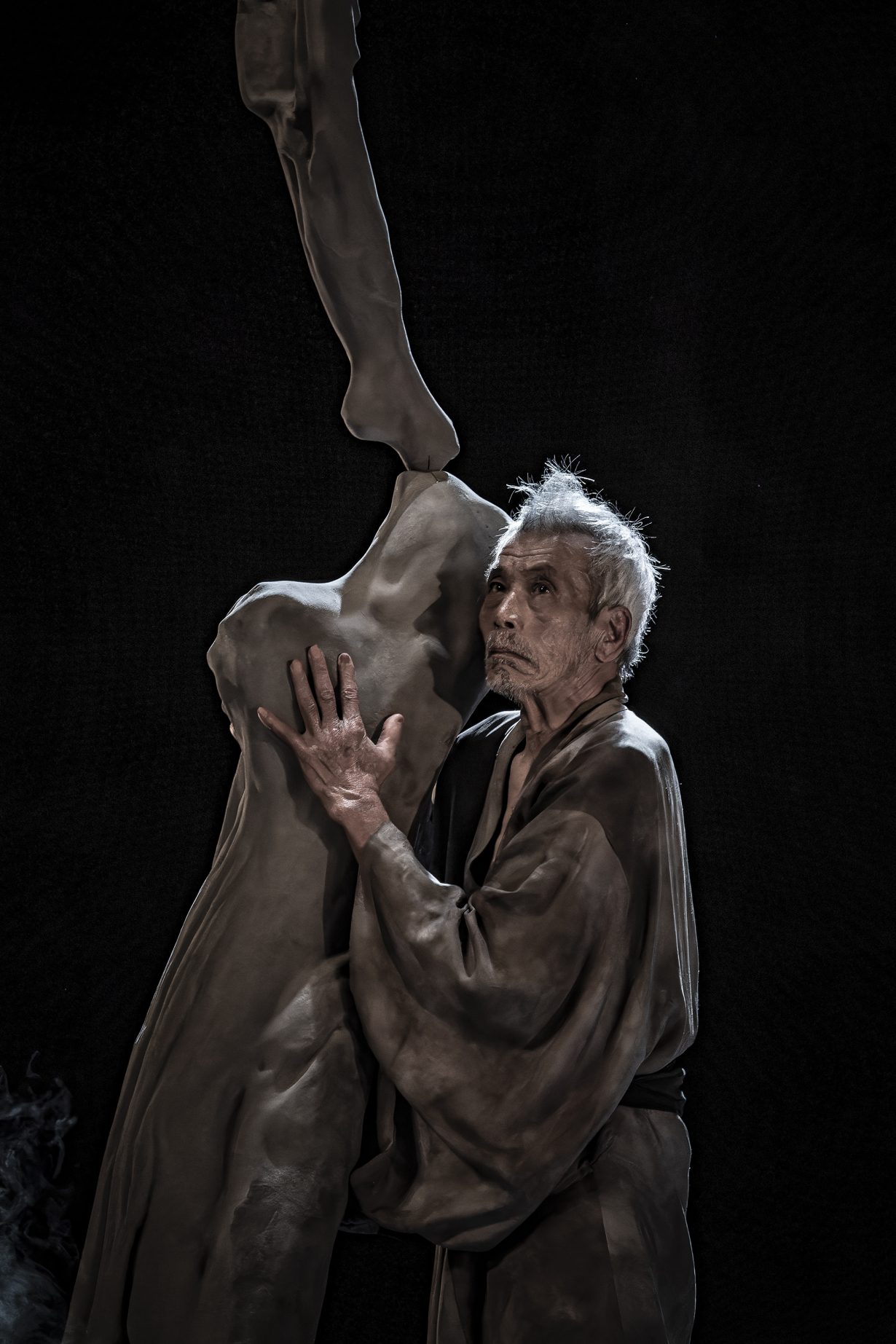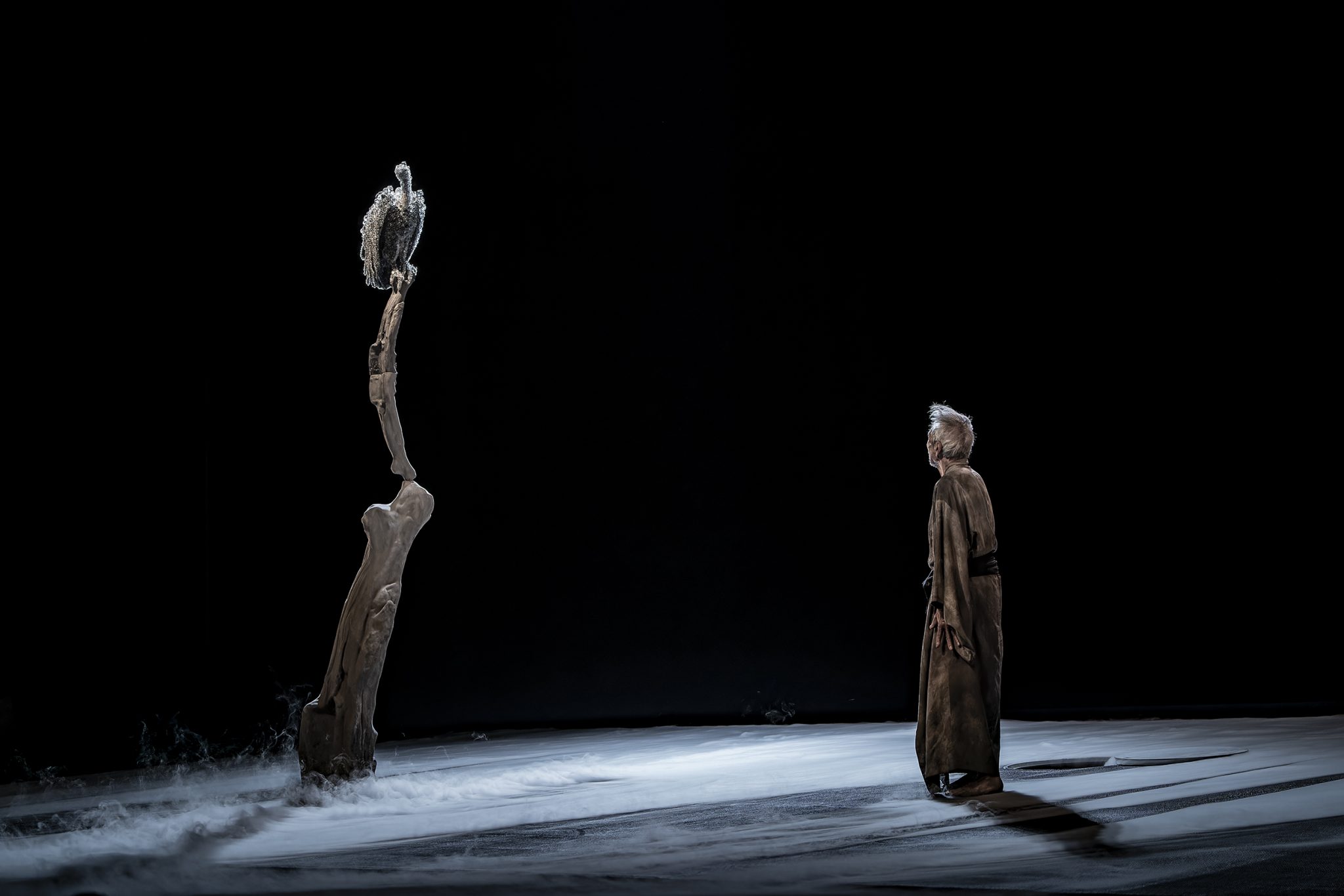In Yamanashi, two of Japan’s most creative minds offer up a dark space of mystery and contemplation
From the Edge is the English title of a performance collaboration between Min Tanaka and Kohei Nawa that took place on 10 and 11 January at the Yamanashi Prefectural Citizen’s Culture Hall in Yamanashi, Japan. But this event was not a mere pairing of famous talents. Despite being from different generations and practicing in different artistic fields, Tanaka and Nawa have known each other for three decades, and their artistic affinity began in this mountainous prefecture.
Now in his late seventies, in recent years Tanaka has become a highly respected actor within his country’s commercial film industry. But what makes him a true cultural icon in Japan is his unique contribution to the art and philosophy of dance. A veteran of Japan’s avant-garde, he started as a dancer during the early 1970s, quickly gaining recognition for his idiosyncratic and daring experiments, which included shocking his audience by dancing naked or deliberately making his body encounter obstacles in alarming ways. In the 2021 documentary film about him, aptly titled The Unnameable Dance (directed by Isshin Inudo), Tanaka repeatedly implies that, when he dances, his intention is not to dance but to be dance.
In 1985, Tanaka and his associates took up farming in the rural town of Hakushu in Yamanashi. The reason was both economic and conceptual. The farm was a way for Tanaka and his workshops to be self-sustainable, while the physical labour of farming would condition the body to perform movements that made dance indistinguishable from living and vice versa. In 1988, it evolved into a summer festival that included participants from around the world. There were no outdoor art festivals in Japan at that time; this one pioneered such events, which now flourish across the country.
Art Camp Hakushu focused on giving children and students a chance to experience and explore new ideas about art and life through various activities on the farmland. It was there that the young Nawa first met Tanaka. Nawa, now one of Japan’s most recognisable contemporary artists, volunteered at the camp in 1994, while he was an art student. Known primarily for his perception-bending sculptures and installations, there seems to be little relationship between Nawa’s own work and Tanaka’s explorations in dance, yet Nawa cites his encounter with Tanaka as seminal to his artistic development. In the statement accompanying From the Edge, Nawa relates that the experience at Art Camp Hakushu ‘drastically expanded [his] horizon in seeking [his] own sculptural expression where materiality plays a key role, ranging over perception, phenomena, architecture, theatrical art, and even public art’.
The Japanese title for From the Edge, 彼岸より (higan-yori), has significantly more nuance than the English. ‘Higan’ is a Japanese Buddhist term, meaning something like ‘the other realm’ that is both spiritual and literal, as in ‘the afterlife’. It is, therefore, also a phrase that brings to mind allusions to religion and spirituality, a context that is missing in the English translation.

Taking inspiration from the classic 1212 memoir, Hōjōki 方丈記, written by the reclusive monk Kamo no Chōmei, From the Edge is based on a Buddhist view toward a certain state of life, a threshold-crossing epoch – and not a pleasant one. Hōjōki is a contemplative record of natural disasters, human conflicts, the degeneration of values, old age, self-doubt and death; but in the Buddhist view all of it falls under the law of impermanence. What humans may perceive as morbid is simply a fact of life and nature; yet impermanence remains devastating to most humans. In their collaboration, Tanaka and Nawa explore the theme of impermanence through a metaphorical push and pull between life in this realm and the other realm. The effect is a stunning, albeit inevitably dark, meditation on the violence and pain one must endure on the brink of life and nonlife.
The stage gradually lights up, slowly revealing a vertical form that stands slightly off to one side. The tall object is soon recognisable as a vulture standing atop a dead tree trunk. The vulture is entirely covered in transparent glass beads of various sizes, the technique that has become Nawa’s signature since his PixCell series (2002–). For those familiar with his work, it is clear from the start that this was a Nawa set. Moments later, the floor is covered in a flowing sheet of white smoke, giving the impression of mist over a river’s surface. Tanaka emerges from beneath the stage, through a circular opening that resembles a manhole, dressed in a ragged kimono. He begins to move, interacting with the patterns created as he penetrates the mist. Music then starts to join the flow. Composed by Marihiko Hara, this ethereal, subtly haunting soundscape spreads and retracts harmoniously with the general flux of Tanaka and Nawa’s collaboration.
Though Tanaka is clearly playing a character, one affected by the dynamic environment, his identity remains an enigma throughout the performance. He creeps up to the vulture, sometimes seeming to imitate it, at other times appearing to seek connection with it. He spins the tree trunk around, as if to show the entirety of the landscape to the bird. The vulture is, of course, a symbol of death; but here its meaning seems to be more nuanced.

The performance is made up of a similar set of ambivalent, loaded actions. Nawa’s set design was deceptively minimal, with only the vulture-occupied dominant vertical structure, the flowing mist, and a subtle pool of red liquid that, in the dark, is barely visible. But the rhythm and the ‘shape’ of the mist constantly changes throughout the performance, using precise programming based on close studies of air movements. Tanaka retreats toward the back of the stage and, removing his kimono, steps into a pool of red, mudlike liquid. He then goes back toward the manhole from which he came and throws his soiled kimono into it. This is followed by a bulb of glowing light that is lowered directly from above, until it too disappears into the hole. Almost immediately a long, glittery rod shoots straight up from the hole, as if to replace it. Tanaka grabs the rod and begins to move around with it, as if it were an extension of his body. The rod, revolving around the stage, is notably longer in proportion to the other objects on the set, creating an unsettling sight that adds yet another riddle to a mystifying narrative. When the rod is eventually discarded, the ground is set ablaze in red light and the mist recedes. A realm-changing event had just taken place, but what was it? Characteristic of both Tanaka’s dance and Nawa’s art, From the Edge did not provide answers; it provoked contemplation.
Towards the show’s final act, Nawa introduced surprises with his clever use of lighting, allowing Tanaka to imply simultaneous engagement with fire, blood, magma and volcanic activities – all of which were consequential in the Hōjōki. From the Edge ends with a sudden burst of terror, a kind of silent scream that is somewhat unexpected. It leaves a lingering sense of chaos and unease, an effect not usually associated with Buddhism or Buddhist-inspired contexts. Yet it is a conclusion that felt, abrupt as it was, in keeping with Tanaka and Nawa’s poetic, sensual collaboration inspired by impermanence.
Prabda Yoon is a Thai writer, filmmaker and occasional artist based in Bangkok
